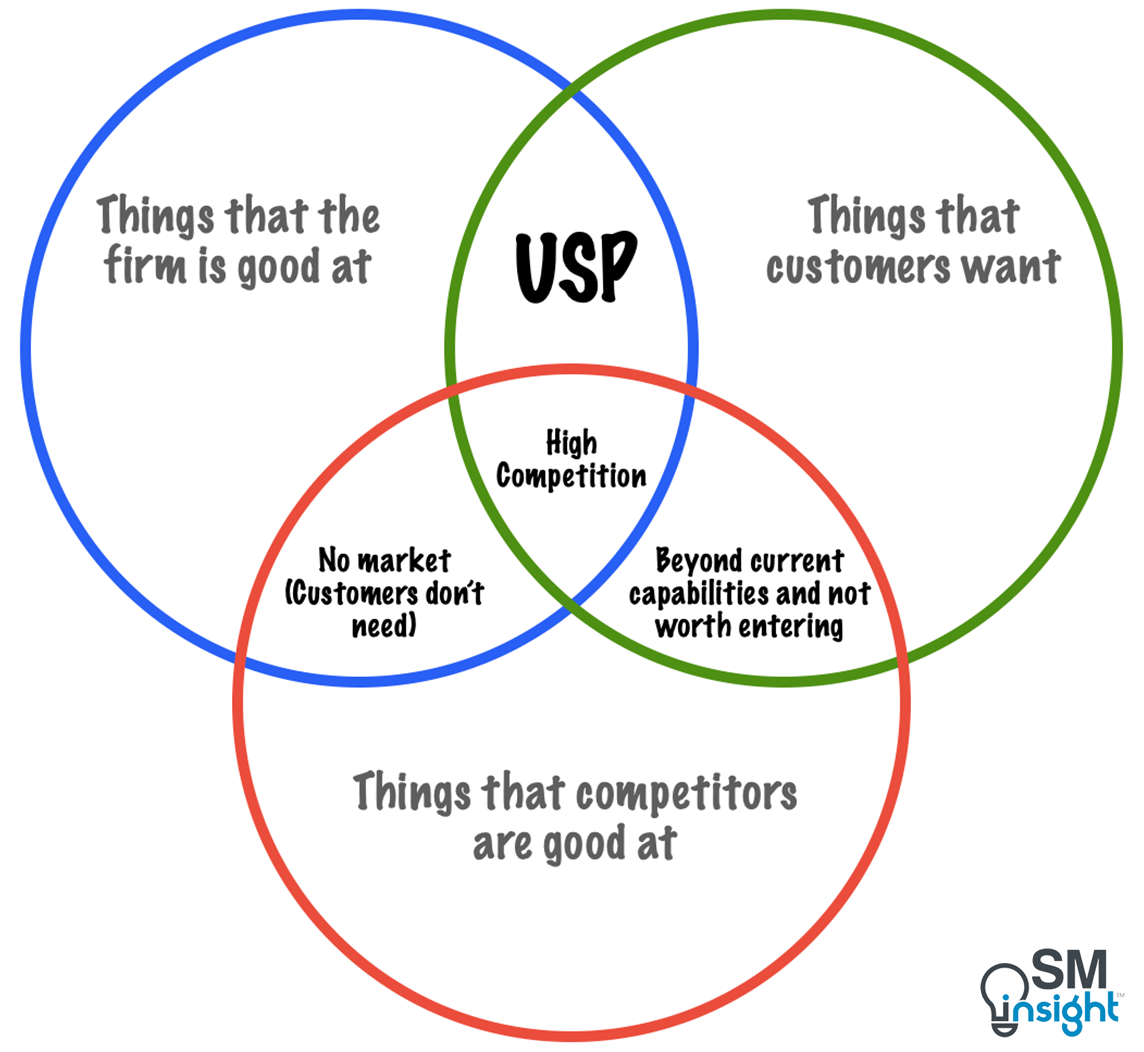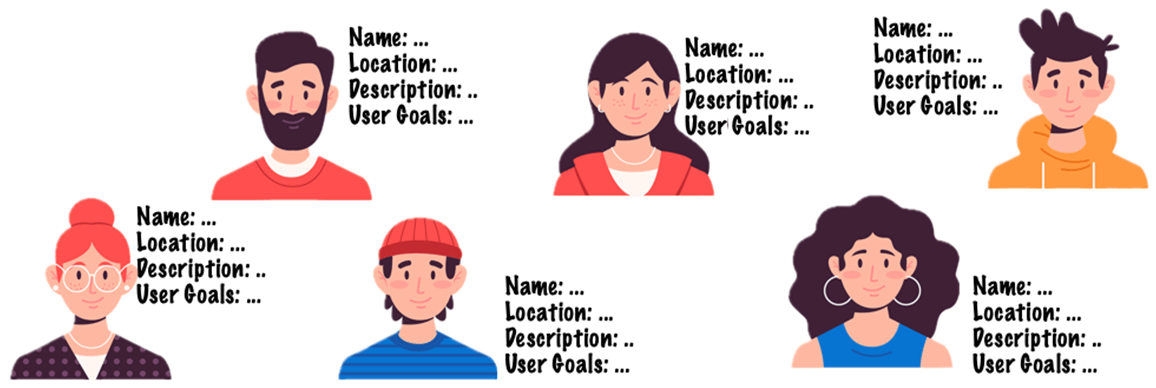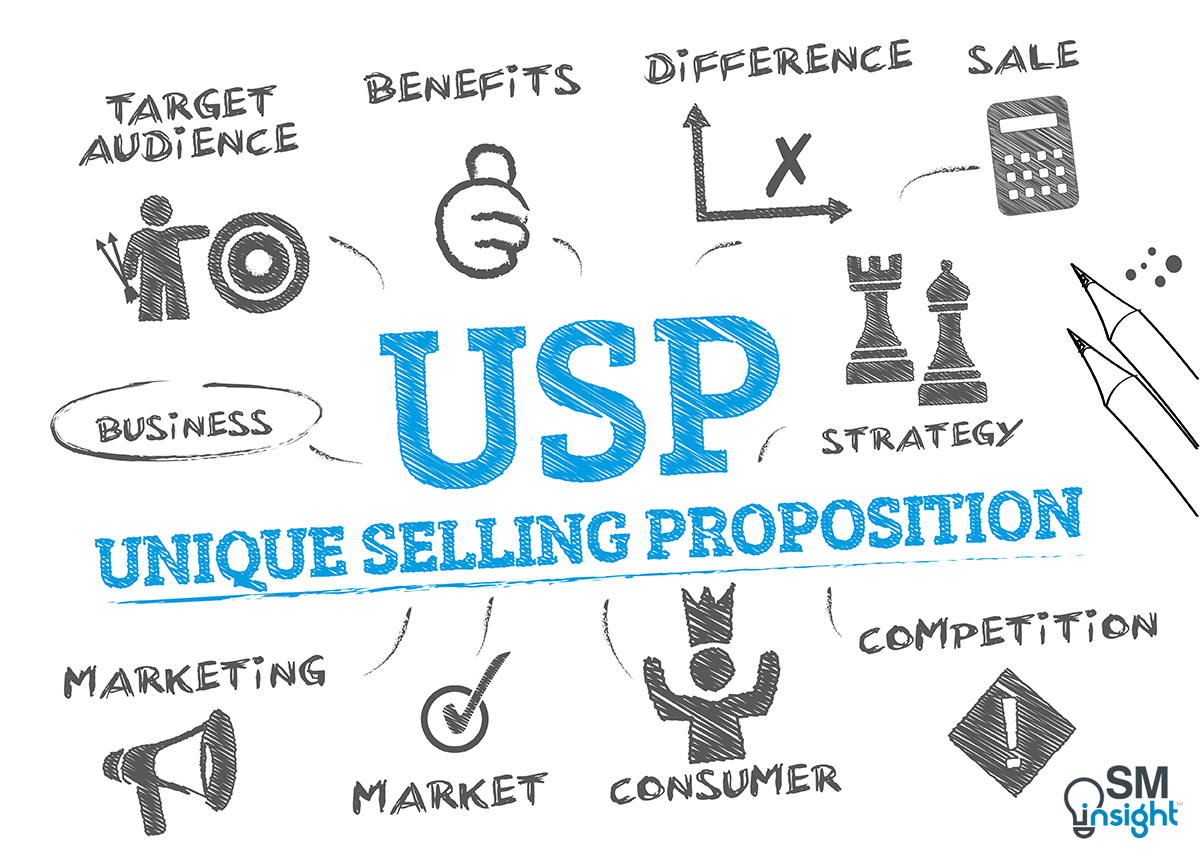A Unique Selling Proposition (USP) is a quality unique to a business’s product or service that differentiates it from its rivals and compels customers to make a purchase.
The concept’s origin dates to the 1940s when advertising agencies used it as a tool to develop strong messages to communicate to target audiences. The term was coined by television advertising pioneer Rosser Reeves of Ted Bates & Company [1].
In his book, Reality in Advertising [2], Reeves describes three key points that sum up to define a USP:
- A product or a service must have (or rather be perceived to have) an evident proposition – “Buy this product, and you will get this specific benefit”.
- The proposition must be one that the competition either cannot or does not offer. It must be either a uniqueness of the brand or a claim that others cannot make.
- The proposition must be so strong that it has the power to move the masses, in other words, it must pull new customers.
Using the above principles, Reeves developed a television commercial in the 1950s for Anacin, an analgesic for headaches, that featured the USP of the product. The ad lasted seven years, grated and annoyed most viewers but tripled the product’s sales [3].
The ad’s success stemmed from its clear, potent claim (“like a doctor’s prescription”) which was repeated for years, and the fact that it relied on the audience’s ability to reason going against the trend toward emotional, not rational, appeals at the time.
Evolution of USP
The term USP originated in the field of advertising in the 50s. It was a product era where a firm with a “better mouse trap” and some money could promote its product.
But soon came the technology era where it became increasingly difficult to establish USP amidst an avalanche of me-too products that flooded the market. The “better mousetrap” was quickly followed by two more just like it claiming to be better than the first one in a market where competition was fierce and not always honest.
Then came the image era where successful companies discovered that reputation, or image, was more important in selling a product than any specific product feature.
But just as the me-too products killed the product era, the me-too companies killed the image era as every company tried to establish a reputation for itself. The noise level became so high that relatively few companies succeeded.
Today, firms operate in a market where advertising creativity is no longer the key. To succeed in an overcommunicated society, they must create a position in the prospect’s mind – a position that takes into consideration not only a company’s own strengths and weaknesses but those of its competitors too.

The idea of USP today stands usurped by the view that what really matters in marketing a product or service is its positioning and where it sits on the spectrum of customer needs.
For example, automobile brands today claim to address all sorts of customer needs and place themselves in different positions – comfortable and reliable, powerful, and economical, feature-rich and sophisticated, rugged and tough etc. However, few (almost none of them) can claim to have a USP. For every Honda, there is also a similar Hyundai.
Thus, it has become more important to link the brand position with a strong claim about what makes the company special. The brand-positioning concept today has become more important than the product-positioning concept.
The eight-step process to discover USP
In the modern context, the term USP relates better to the uniqueness of a firm rather than the uniqueness of a product. It is not necessary (and extremely difficult) to find a product at which a firm is the absolute best. Most companies must compete against firms that have quite similar offerings.
But this does not mean a firm cannot find something that stands out as its own ‘high ground’. For most firms today, their USP lies in the thin zone that overlaps what they do best with what their customers want and avoids those areas where their competitors do better:

Thus, to have a USP, firms must find something that matters to customers and that no one else has (yet) made their forte. If a firm can defend its ability to provide that USP, it can use it as a lasting advantage.
In discovering USP, firms can make use of the eight-step process:
Step 1: Identify the target audience
The term “target audience” refers to all the people that the firm intends to reach with its idea, product, or service. Identifying the target audience automatically narrows down potential customers, although they remain faceless.
Firms can also use Customer Personas [5] (also known as “Buyer Personas” or “Marketing Personas”) which are fictional representations of the target customer audience. Personas give a concrete but fictional face to the customers and delve into the stories of buyers and their consumer behaviour.

In the Business-to-Business (B2B) context, a firm can ask additional questions such as:
- What is the nature of the decision-making?
- What is the composition of a decision-making team?
- Describe the “persona” of a decision-maker.
- Describe the “personas” of those who may influence the decision.
Developing Personas for the target audience helps in the next step which is to identify their needs.
Step 2: Identify the needs of the target audience
The target audience will have a variety of different needs. Those needs create demand in the market that decides whether something can be successfully marketed. It is important that a firm seriously considers the factors that potential customers could find interesting and desirable along with their reasons for the same.
Needs are not always about objective qualities; they also include subjective perceptions.
For example, a customer may choose an eco-friendly laundry detergent not only because it is good for the environment but also because he/she feels good about doing something right.
Potential emotional and psychological considerations can be strong drivers. No matter how big or small, a firm must identify and list all the needs of the target audience.
A firm can ask the following questions to better identify the needs of the target audience:
- What makes people go for the firm’s product and what prompts them to do so?
- To what extent do people buy competitor’s products? What prompts them to do so?
- What does a firm’s product offer that competitors cannot?
- What is a competitor’s central message when they promote similar products?
- Beyond the obvious, what are some subtle differences between a firm’s product and its competition?
Step 3: Identify the unmet needs of the target audience
While customer needs can be far and varied, so are competitor’s offerings that race to meet those needs. The key to building a USP lies in identifying those grey areas where there is an unmet customer need that the competition hasn’t noticed or is unable to address.
The following questions can help a firm identify unmet needs:
- How would a perfect product that meets every customer’s need differ from the existing product?
- To what extent does the current product meet the customer’s needs? Where is the gap?
- Whose needs within the decision-making unit are not fully met (B2B)?
- If the gaps were to be met, how big an advantage would this be over the competition?
Identifying unmet needs is a good way to narrow down the list before scrutinizing the opportunities that are worth pursuing.
Step 4: Rank the needs and unmet needs
A firm must organize the identified needs in order of importance to the target audience. This includes both the met and unmet needs of the customer (those identified in Steps 2 & 3). Such a ranking provides a clear hierarchy and aids in prioritization.
There are two important aspects to be considered when ranking a need:
- How important is it to the customer
- How well do products currently in the market satisfy those needs
If a desired product feature is valued but unsatisfied, it’s a potential opportunity for the firm to offer and enhance its product appeal. A firm can undertake such a study based on the views of market research, the sales team, or customer enquiries.
The table below provides an example of how customers see the importance of various smartphone features (Col A) and their current satisfaction level (Col B) on a scale of 1-10.
| Customer need (Smartphone) | A. Importance to customer | B. Satisfaction level with existing products in market | C. Opportunity C = A x (10-B) | D. Opportunity Score |
|---|---|---|---|---|
| Operating System | 5 | 3 | 35 | ***** |
| Connectivity | 6 | 5 | 30 | ***** |
| Storage Capacity | 7 | 6 | 28 | **** |
| Build Quality | 3 | 2 | 24 | **** |
| Battery Life | 3 | 3 | 21 | **** |
| Display Quality | 4 | 5 | 20 | *** |
| Performance | 10 | 8 | 20 | *** |
| Brand Value | 9 | 8 | 18 | ** |
| Camera Quality | 2 | 4 | 12 | * |
| Price | 6 | 8 | 12 | * |
These features are then arranged in descending order by considering both, the importance to the customer and the current satisfaction level to calculate an opportunity score (Col C).
Col D shows the opportunity that exists for the firm to address the unmet need that both customers value and the market currently doesn’t provide.
Step 5: List all the elements of the firm’s value proposition
A firm’s value proposition is made up of all the different features and benefits of its product together with supporting services. This must be weighed against its relative importance in the eyes of the target customer.
For example, the iPhone’s value proposition includes seamless integration of hardware and software, a sleek design, and a user-friendly ecosystem that comes with Apple’s brand value and reliability. The iPhone would rank high in the eyes of a customer who uses the phone for messaging, checking emails, social media and taking pictures.
But if a chosen persona (target audience) is a “Gamer”, then the iPhone may not rank high.
This is evident from the fact that Asus sells its ROG phone at a price higher than the iPhone to a select set of customers who value gaming performance [6].
The table below (Col E) shows an example of how a firm can rank its own capabilities to meet the opportunities that are identified in Step 4.
| Customer need (Smartphone) | D. Opportunity Score | E. How well is firm placed to address this need |
|---|---|---|
| Operating System | ***** | * |
| Connectivity | ***** | **** |
| Storage Capacity | **** | **** |
| Build Quality | **** | ** |
| Battery Life | **** | * |
| Display Quality | *** | ***** |
| Performance | *** | ** |
| Brand Value | ** | ** |
| Camera Quality | * | ** |
| Price | * | *** |
Factors such as potential market size, likelihood of maintaining lead, and feasibility must be considered. The needs of customers can be very different and there are always pockets of opportunities for firms to spot and capitalize.
Step 6: Match the value proposition against competitors
A firm’s value proposition cannot be seen in isolation. It must be seen in the context of what the competitors are able to offer. This helps identify value propositions that stand out as different or better than those of the competition.
This helps a firm find areas where it’s likely to be noticed and successful.
The table below (Col F, G, H…) shows how competitors are placed in terms of their value proposition in addressing the identified opportunities:
| Customer need (Smartphone) | D. Opportunity Score | E. How well is firm placed to address this need | Col F Competitor 1 | Col G Competitor 2 | Col H Competitor 3 | … |
|---|---|---|---|---|---|---|
| Operating System | ***** | * | *** | **** | * | ** |
| Connectivity | ***** | **** | ** | **** | **** | *** |
| Storage Capacity | **** | **** | ** | * | ** | *** |
| Build Quality | **** | ** | *** | *** | * | **** |
| Battery Life | **** | * | *** | **** | **** | *** |
| Display Quality | *** | ***** | * | ** | ** | * |
| Performance | *** | ** | **** | ** | *** | ** |
| Brand Value | ** | ** | **** | *** | ** | *** |
| Camera Quality | * | ** | * | ** | **** | *** |
| Price | * | *** | ** | **** | * | **** |
Step 7: Consider process aspects that appeal to the customer
A USP can also be the process that a firm uses to create its products. Firms use complex processes to create products that meet customer expectations. This includes the sources of raw materials used, the method of processing, quality checks, etc. that can be used as indicators of something special for the customer.
For example, Japanese chef’s knives are world-renowned for their unique design and durability. Those manufactured by Takamura Hamono in Echizen, Japan, can sell for well over $1000 in a market where the regular piece sells for less than $20 [7].
What sets it apart is the process of manufacturing– from heating and hammering the metal to sharpening the knife’s edge and polishing the final blade, skills that Japanese artisans dedicate a lifetime to mastering.
To identify important process aspects, a firm can ask the following questions:
- What special processes are used to ensure that the product is of high quality?
- In what way is the product quality ensured after the customer has bought it? (Ex: over-the-air updates, free check-ups)
- Are there any unique aspects to how the products are made?
- What is special about the raw materials used?
- Are there people-related skills unique to the organization that ensure a better product?
- How does the product meet the needs of the environment?
Step 8: Select a benefit, a feature or a story that resonates
Once a firm has analyzed the customers’ needs, unmet needs, its customer value proposition, the competitive situation, and the value chain by which its products are made, the next step is to identify that single attribute which appeals to the target audience.
Discovering USP is about identifying that one thing unique to the firm, the most compelling reason why customers would want to come to the firm.
Take Tesla as an example, which took its goal to accelerate the advent of sustainable transport and turned it into a USP. Tesla’s vision inspired its customers who saw themselves as pioneers and early adopters of the new technology.
A study by JD Power found that despite spending over $100,000, Tesla’s early customers were tolerant of the problems in Model S and Model X which seemed to have little influence on the overt affection owners had for the brand [8].
Crafting a USP
Once a firm has identified its strong points in the context of the market and relative to its competition, it can begin developing an effective message around its USP. Ideally, the message should gain attention, hold interest, arouse desire, and elicit an action (The AIDA model [9]).
However, in practice, few messages take the target audience all the way from awareness through purchase, but the AIDA framework suggests the desirable qualities of any communication.
A USP must have a strong appeal which can be either of the three types [10]:
- Rational appeal – Engages self-interest by claiming the product will produce certain benefits such as value or performance.
Industrial buyers are most responsive to rational appeals because they are knowledgeable about the product, trained to recognize value, and accountable to others for their choices. Consumers, when they buy certain big-ticket items, also tend to gather information and estimate benefits. - Emotional appeal – Attempts to stir up negative or positive emotions that will motivate purchase. Even when the product is similar to the competition’s product, it may have unique associations that can be promoted (examples are Harley-Davidson and Rolex).
Communicators also work with negative appeals such as fear, guilt, and shame to get people to do things (brush their teeth) or stop doing things (smoking). In addition, positive emotional appeals such as humor, love, pride, and joy are often part of the message content. - Moral appeal – these are directed to the audience’s sense of what is right and proper. These are often used to exhort people to support social causes. An example is the appeal “Silence = Death,” which is the slogan of Act-Up, the AIDS Coalition to Unleash Power.
Firms can also use the following elements to bring out uniqueness in their USP [11]:
- Offering the lowest price – A firm can use this to position itself as a low-cost option. This is the Walmart strategy which has been known for its unique selling proposition of offering goods at “Everyday low prices”.
But this is a rocky route to success, particularly at a time when firms backed by VC funding are prepared to sell (temporarily) at well below cost just to establish turnover. - Offering the highest quality – This is the Rolls Royce or the Rolex approach, where a firm promotes quality first and commands premium.
- Offering exclusivity – the firm offers a unique packaging of information or knowledge not available elsewhere.
- Offering the best customer service – promotes excellence in customer service (such as an impeccable response time and customized support). An additional benefit of this USP is that it compels the firm’s employees to try harder to achieve the promise.
- Offering the widest choice – particularly appropriate to niche markets, a firm provides its customers access to hard-to-source products. A luxury perfume shop may, for example, claim to offer a wider selection of perfumes than anyone else.
- Giving the best guarantee – this is particularly important in industries such as travel and catalog selling, where customers pay for something upfront and then have to hope that what they think they have bought is eventually delivered.
Examples of good USPs
Avis‘s slogan “We’re number two. We try harder” was launched in the early 1960s. It was a way to differentiate Avis from its main competitor, Hertz. The slogan was also a reminder that Avis would provide the best service and value to its customers.

FedEx Corporation – “When it absolutely, positively has to be there overnight.” FedEx no longer uses this slogan, but while it lasted it was perhaps the perfect example of a great USP. In a few words, FedEx gives its customers the guarantee that it will deliver their packages safely and on time.
M&Ms – “The milk chocolate melts in your mouth, not in your hand.” was an example of how even a quirky USP can attract customer interest.
DeBeers – “A diamond is forever.” DeBeers slogan has been in use since 1948 and is still used by the company to this day. The USP here is that (DeBeer’s) diamonds, being almost unbreakable, last forever and thus are the perfect symbol of eternal love. (Emotional appeal)
Sources
1. “Bates Worldwide, Inc.”. Encyclopedia.com, https://www.encyclopedia.com/social-sciences-and-law/economics-business-and-labor/businesses-and-occupations/bates-worldwide-inc. Accessed 15 Mar 2024.
2. “Reality in Advertising”. Rosser Reeves, https://www.amazon.com/Reality-Advertising-Rosser-Reeves/dp/098269413X. Accessed 13 Mar 2024.
3. “ANACIN”. Adage, https://adage.com/article/adage-encyclopedia/anacin/98317. Accessed 13 Mar 2024.
4. “Positioning: The Battle for Your Mind”. AL Ries, Jack Trout, https://www.amazon.com/dp/0071373586?ref_=cm_sw_r_cp_ud_dp_6M6R84XH3VGM81SCJC66. Accessed 14 Mar 2024.
5. “Tips for creating customer personas”. Presentationload, https://www.presentationload.com/blog/tips-on-creating-customer-personas/. Accessed 15 Mar 2024.
6. “Asus ROG Phone 7 Ultimate review: High score”. Androidpolice, https://www.androidpolice.com/asus-rog-phone-7-review/. Accessed 14 Mar 2024.
7. “Japanese chef’s knives can sell for hundreds of dollars each. Here’s what makes them so expensive.”. Business Insider, https://www.businessinsider.in/retail/news/japanese-chefs-knives-can-sell-for-hundreds-of-dollars-each-heres-what-makes-them-so-expensive-/articleshow/84565861.cms. Accessed 14 Mar 2024.
8. “Beyond the Hype”. J D Power, https://www.jdpower.com/business/press-releases/tesla-beyond-hype. Accessed 14 Mar 2024.
9. “AIDA Model”. Corporate Finance Institute, https://corporatefinanceinstitute.com/resources/management/aida-model-marketing/. Accessed 20 Mar 2024.
10. “Marketing Management”. Philip Kotler, https://www.amazon.com/Marketing-Management-Philip-Kotler/dp/1292093234. Accessed 20 Mar 2024.
11. “Guide to Management Ideas and Gurus”. Tim Hindle, https://www.amazon.com/Guide-Management-Ideas-Gurus-Hindle/dp/1846686075. Accessed 20 Mar 2024.
12. “We are number two but we try harder: the underdog narrative of progressivism”. Othmar’s Trombone, https://othmarstrombone.wordpress.com/2015/02/28/we-are-number-two-but-we-try-harder-the-underdog-narrative-of-progressivism/. Accessed 20 Mar 2024.

